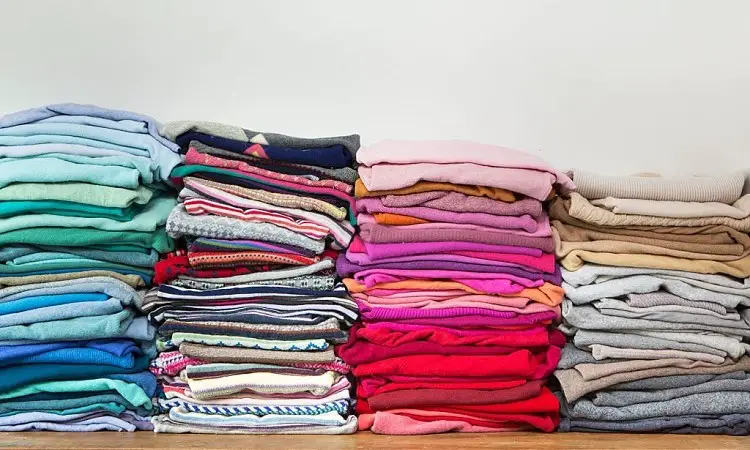Fabric Stiffeners make fabrics easier to manipulate into any desired form. Some stiffeners hold the clothes permanently, while others are just temporary.
If you are into fashion design designing, you may need to keep your fabric in a particular shape. You would need a fabric stiffener to achieve this.
This article talks about different fabrics you can stiffen and how to use fabric Stiffeners to achieve stiffness.
Table of Contents
What is a Fabric Stiffener?
The phrase “fabric stiffener” may sound very formal and sophisticated to some people, but a fabric stiffener is any substance or material that holds the fabric in a particular shape.
The fabric stiffener hardens and holds the fabric to maintain its form.
If you’re familiar with different fabrics, you would understand that not all fabrics retain the shape you desire, some fabrics are just too soft and flexible, and the only way to make them retain a shape is by using a stiffener.
These stiffeners come in different weights and thicknesses, and depending on what project you’re working on, not all stiffeners fit all projects.
Two main fabric stiffeners are available; Temporary stiffeners like sugar, cornstarch, hairspray, glue, or wallpaper paste.
Other stiffeners like bonds, commercial sprays, or interfacing are permanent stiffeners.
For many fashion designers, interfacing is their best bet because of how easily it adheres to different fabrics.
Interfacing iron-on is a good stiffener for forming neck collars and cuffs; however, spray-on stiffeners can also suffice for some fabrics.
How to Use Fabric Stiffeners

Stiffening fabrics are useful to fashion designers and sculptors. Artists and other crafters make use of fabric stiffeners for their art.
If you belong to any group, you may wonder how to use fabric stiffeners to maintain a form.
Some common methods to permanently stiffen your fabric include
Iron-on Interfacing
This is a favorite one for those in the fashion industry. This method effectively holds a fabric shape and provides extra padding that gives the cloth a fuller look.
By simply sandwiching the interfacing fabric between your fabric and a lining and ironing it, the shiny side of the interfacing melts into the fabric to hold it together. You’d mostly find it in collars, cuffs, and buttonholes.
How to use
- Prewash the fabric you intend to stiffen.
- Even though not many sewers practice prewashing, to be safer, prewash your fabric before stiffening it to avoid a situation where the fabric and the stiffener shrink at different levels.
- Select the pieces of fabric you intend to stiffen. For instance, if you want to pad the cuffs or collars, keep them separately from the rest of the fabric.
- Carefully lay the shiny side of the stiffener on the inner part of your fabric.
- Heat the iron to the tested temperature that you’re sure won’t damage your fabric, and use it to iron the padded fabric.
- After ironing, tug on the interfacing to see that it has melted adequately into the fabric.
- You can use interfacing on many fabrics, but not all fabrics work with it, especially see-through fabric, because the interfacing itself appears like another fabric. It’ll be obvious if you’re using a different fabric color.
Hint
Try a mock work by cutting pieces of the stiffener and the fabric you intend to stiffen.
Set your iron to a moderate temperature, place the interfacing on the inner part of the fabric, and use the heated iron to press them together.
Observe the outcome and note the heat to be sure not to melt or burn your real fabric.
Glue Stiffener
Glues (like PVA glues) fit into many crafts and domestic work. You can use them on wood, plastic, rubber, or even to stiffen fabrics.
Many popular tubes of glue we use at home are water soluble; even though they may be a good adhesive, they can dissolve in water.
Ironically, a combination of water and glue forms a good fabric stiffener.
How to use
- First, mix equal quantities of water and glue in a bowl. Ensure that the mixture is in a balanced proportion because more glue would make the solution too thick, and more water would make it too thin and less effective.
- If the project is large and requires much fabric, soak the fabric in the mixture for some minutes, take it out, and mold it into the desired shape.
- You can also have the fabric molded without first soaking it in the mixture, then use a brush to deep and apply on molded fabric.
- Using glue to stiffen fabrics is favorable for sculptors.
Gelatin
Gelatin is a good source of collagen. It contains a reasonable amount of protein that can garden and form a stiffener. Although soluble, it dries up quickly to stiffen the fabric.
How to use
- Heat two cups of water to a steaming degree. That is, it shouldn’t boil, but it should be hot.
- Mix a tablespoon each for the cups of water.
- Mix properly and let it cool for an hour to help activate the gelatin.
- Two cups of water are not the standard, so ensure that the water you’re using is enough to cover your fabric.
- Soak your fabric in the mixture after the gelatin has been activated and let it sit for another hour.
- If you want to create a shape with your fabric, mold it into the shape before inserting it into the mixture.
- After an hour, the fabric should completely soak with the gelatin.
- Take it out of the water and let it dry overnight.
Commercial Stiffeners
This is the most common and easy way of stiffening fabrics. Most commercial stiffeners like Mod Podge Stiffy come in spray bottles with instructions on how to use them, what fabrics they work best with and when to dry them.
They’re made of synthetic glue/starch-like substance that often doesn’t smell so well, is nontoxic or harmful, and is very easy to use.
Mod Podge glue stiffener can stiffen any fabric arts and crafts.
In addition to making fabrics less flexible, this product can be used on cotton, cheesecloth, burlap, gauze, laces, ribbons, and needlework. It is also quick and easy to use.
How to use
- Using a suitable amount, immerse the fabric in a bowl.
- As soon as the fabric is saturated, begin squeezing out the excess. Place the wet fabric flat or over plastic wrap-covered forms.
- If you want to stiffen a doily to create a bowl (for example), lay it over a plastic wrap-covered bowl, and continue working with it until it is centered and does not touch the ground.
- Let it dry thoroughly.
Check out this video to learn how to create handmade fabric crafts with Mod Podge.
Cornstarch
This has been one of the earliest methods of stiffening fabrics. Many homes made DIY fabric stiffeners from cornstarch, even before modern fabric stiffeners.
How to use
- Mix a tablespoon of cornstarch in a water bowl and stir until it completely dissolves. The amount of water to use depends on the work you intend to do. However, ensure that the water is more than the starch.
- Add the mixture to a saucepan and place over low heat. Place it over the fire and start stirring immediately to prevent lumping.
- Once the starch thickens, please remove it from the fire and insert the fabric into the mixture to soak.
- Take it out and leave it to dry overnight.
- While cornstarch is common and easy to use, you can only use it for no washable fabrics. It cannot hold plastic or wood together and is not permanent.
Sugar
Using sugar as a fabric stiffener may be the last thing on your mind, but it works. Even though it is not a permanent stiffener, it temporarily holds well.
How to use
- Add equal quantities of sugar and water into a saucepan and place over moderate heat.
- Stir until the sugar completely dissolves and thickens
- Using cooking tongs, insert the dollies or fabric you want to stiffen in the mixture.
- Take it out after saturated with the solution and leave it to dry overnight.
Wallpaper Paste
Some wallpaper pastes contain starch that can stiffen a fabric when dissolved in water.
How to use
- Mix equal quantities of the paste and water in a bowl.
- Stir it until it completely dissolves in the water, leaving no lumps.
- Soak the fabric in the mixture to absorb the starch.
- Bring it out and leave it to dry.
Related Posts:
DIY Fabric Stiffeners
You can do anything from the comfort of your home with the internet at your fingertips.
You can get a degree, shop, and have it delivered to your doorstep, or even prepare your fabric stiffener without spending so much.
These DIY tips will help you when you need a quick-fix method for preparing a fabric stiffener.
- Measure two cups of rice into a pot of water. The water should be slightly more than the rice.
- Parboil the river to extract the starch in it.
- Once the water is boiled, strain it into a bowl. You can decide to cook the rice and eat it or refrigerate it for later.
- Use another cup of water to dilute the rice water.
- Submerge the fabric into the water and leave it to dry.
This method is easy and reliable, especially if you’re in a hurry. However, it is not permanent, and the water is only effective for the first day.
Alternatively
- Wash and soak a cup of raw corn in cold water and leave it overnight.
- Strain the water the next day and rinse the corn. Blend it into a smooth paste and sieve out the chaff.
- Use enough cold water to dilute the residue and leave it to settle for an hour.
- After an hour, strain the water to reveal the starch. Be careful to avoid remixing the starch while straining.
- Using the cornstarch method, prepare the stiffener.
The DIY tips are more effective for semipermanent stiff. They’re only effective on fabrics or paper but not on plastic and can only last as long as the fabric stays out of water.
FAQs
What does fabric interfacing do?
The purpose of interfacing is to add firmness, shape, structure, and support to certain parts of a garment, such as collars, cuffs, waistbands, and pockets.
It is applied as an additional layer to the inside of garments, such as collars, cuffs, waistbands, and pockets.
Why should I use a fabric stiffener spray?
Spraying reduces the drying time and allows for more precision. Spray outside and in a well-ventilated area to avoid excess glue and overspray.
What is stiffening fabric called?
Fabric stiffeners are called interfacings. They can be heat-activated fusible glue on one side or both sides, or they can be fabrics you stitch into.
There are many types of sewing interfacing, most of which are white or black.
Does hairspray make fabric stiff?
Using spray hairspray will stiffen the fabric, but the effects will only last for a while or be dramatic. Make sure a test area is sprayed first to ensure it will not stain.
Conclusion
Apart from the regular commercial sprays available, there are other ways to use fabric stiffeners to set your fabrics into different forms.
Some may be permanent and others semipermanent, but depending on what you want, each method listed here effectively holds the fabric in shape.
.
